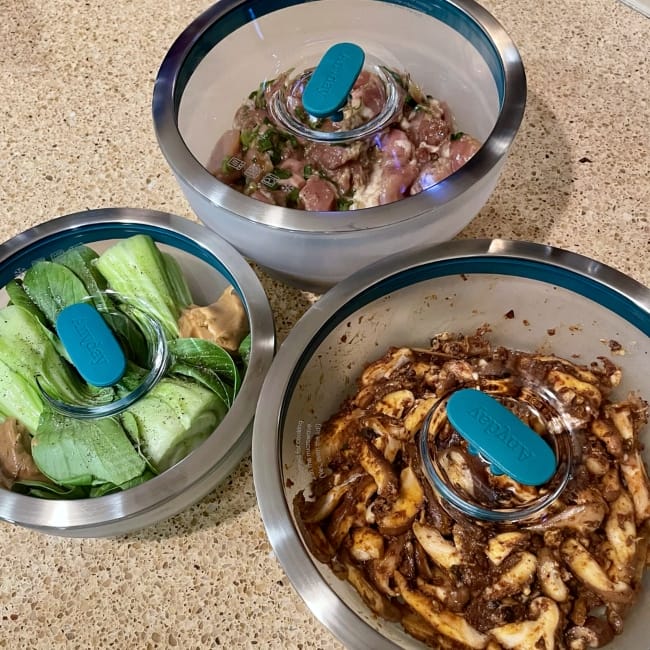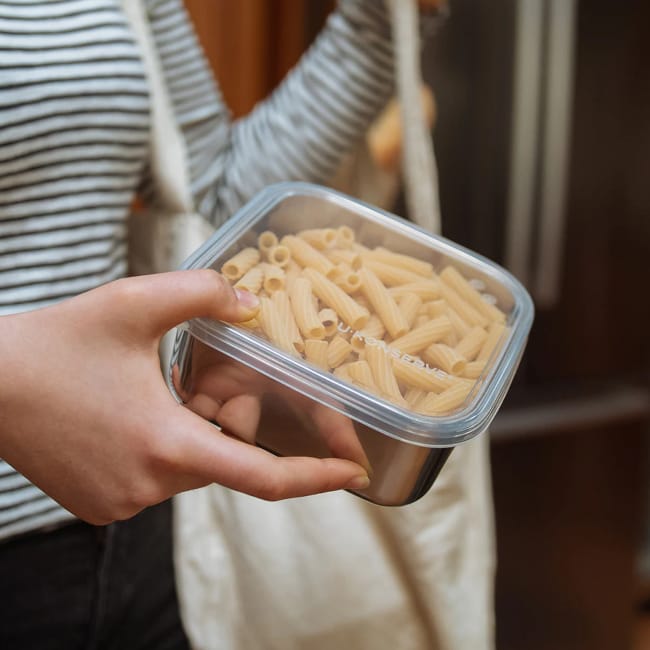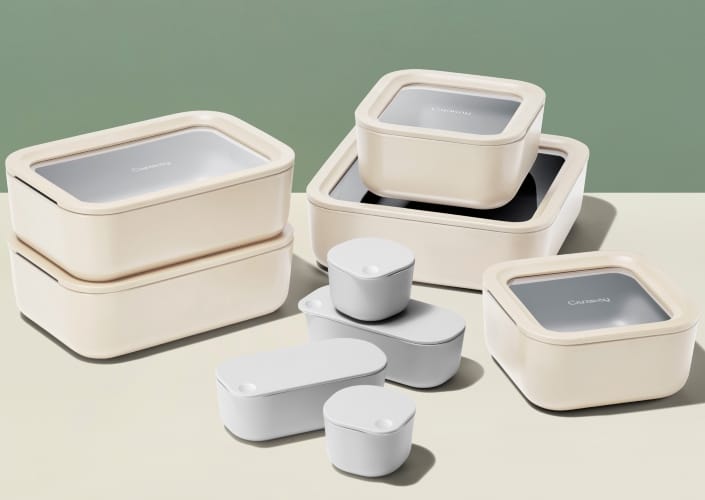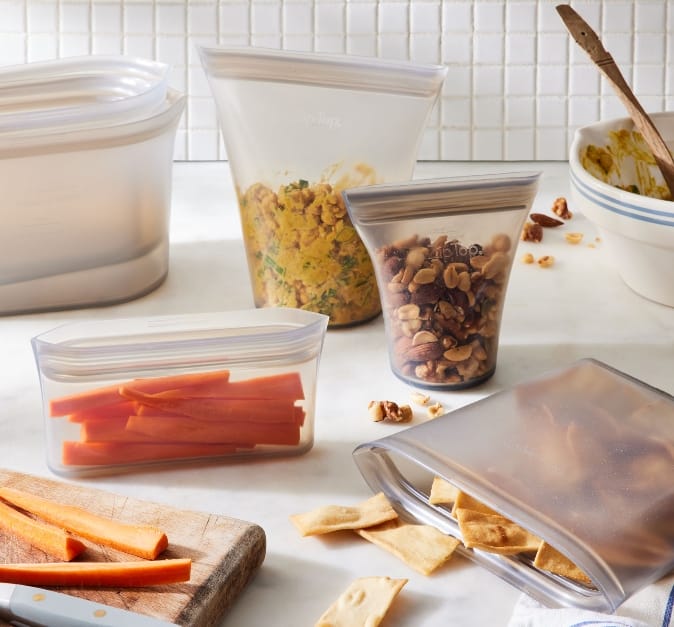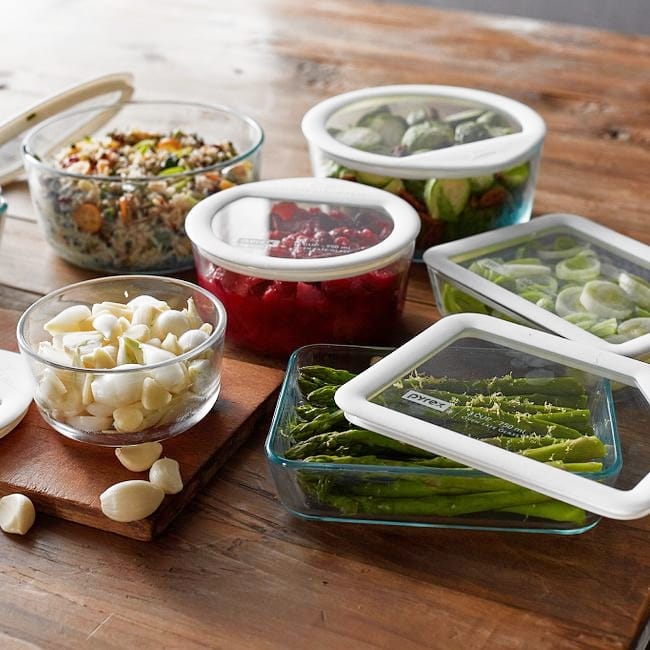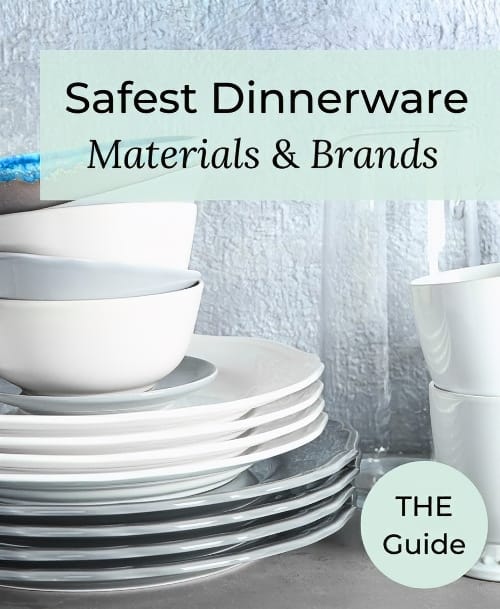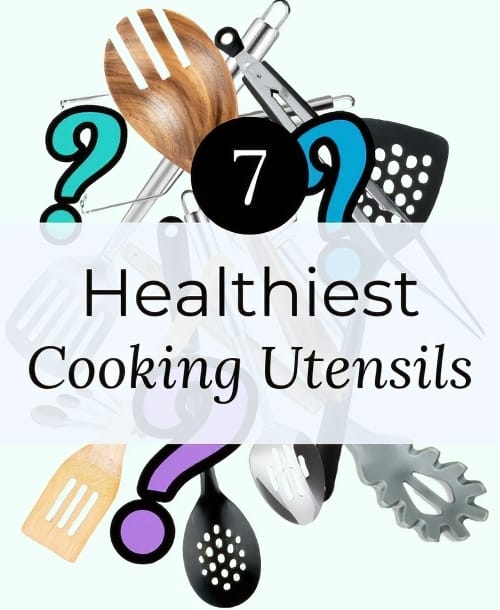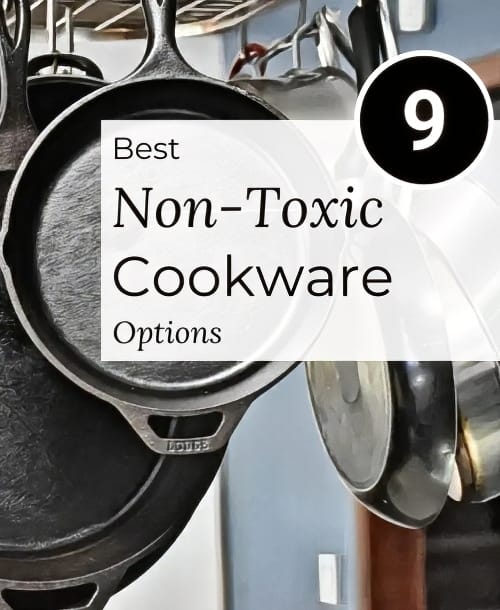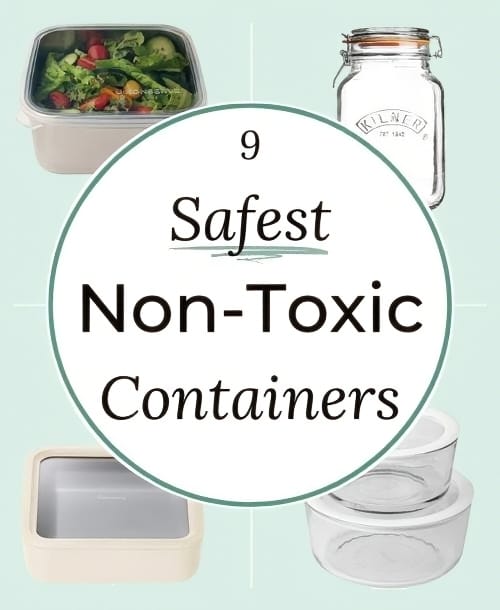
We all know processed foods aren’t great for us. But did you know the containers we use to store food can have a harmful impact on our health and well-being?
Plastic containers can release toxic chemicals like BPAs, phthalates, and microplastics into our food and the environment. Even those labeled “BPA-free” present risks (more on that later).
That’s why we searched the market for the best non-toxic food storage options. What makes a container non-toxic?
First, it needs to be 100% plastic-free – lids included! Instead, the safest materials are those that don’t leach chemicals at all. Glass, stainless steel, silicone, and natural waxes are all great choices.
These are just a few of the strict criteria we used to choose our top nine plastic-free food storage containers. Stay tuned to see exactly which ones we picked and why.
Later, we’ll explore “safer” plastics for food use (and which to definitely avoid). We’ll also share some tips to help you prevent risks when using any plastic container.
Let’s get started!
Medically-reviewed by Dr. Ahmad Alsayes, MBBS
Our Top Picks – Quick Comparison:
| Brands | Materials | Dishwasher-safe? | Leak-proof? | Price Range |
|---|---|---|---|---|
| Anyday (Top Pick) | Borosilicate Glass & LFGB Silicone | Yes | Yes | $35+ |
| U-Konserve | 18/8 Stainless Steel & LFGB Silicone | Yes | Yes | $11+ |
| Caraway | Glass, Non-Stick Ceramic, & FDA Silicone | No | No | $35+ |
| Zip Top | LFGB Platinum Silicone | Yes | No | $10+ |
| Pyrex | Glass & FDA Silicone | Yes | Yes | $80 |
| Seed & Sprout | Borosilicate Glass & LFGB Silicone | Yes | No | $9+ |
| Life Without Plastic | Borosilicate Glass, Bamboo, & FDA Silicone | Yes | Yes | $10+ |
| Kilner Jars | Borosilicate Glass & FDA Silicone | Yes | Yes | $7+ |
| Bee's Wraps | Organic Cotton & Bee or Plant Wax | No | No | $6+ |
What Makes a Container Non-Toxic? Safety Criteria & How We Chose
- Plastic-free: This means 100% plastic-free, including the lid. No sneaky BPA-free plastic! No Bisphenols or phthalates, period.
- Inert materials: Think glass, stainless steel, or silicone. These materials don’t release harmful chemicals or affect your food’s flavor.
- Free of nasty stuff: We’re talking PFAS, lead, cadmium, phthalates, and all Bisphenols. Like your cookware and dinnerware, your food storage should be healthy, too.
- Built to last: Durability matters, regardless of material. Most of our glass picks are borosilicate, which is longer-lasting (more sustainable) than regular glass.
- Eco-friendly: The container should be easily recyclable or compostable.
- Responsible brands: The brand should make an effort to better the planet, both through its products and practices.
- Testing:
- We put containers through the wringer. Leak tests, temperature changes, and even “old food” tests (leaving food in for two weeks!) to ensure they clean easily.
Remember, it’s not just about avoiding plastic. I look for containers that are safe, durable, and good for the planet.
With these criteria in mind, you can be sure you’re choosing the safest options for your food storage needs.
9 Best & Safest Non-Toxic Food Storage Containers: Reviewed
Now let’s explore the best non-toxic food storage containers in 2024 thus far. All nine below passed our extensive criteria evaluation detailed above.
#1: Anyday (Top Pick Overall)
- Materials: Frosted borosilicate glass body; lid. LFGB-certified platinum silicone seal. 100% Plastic-free.
- Appliances: Freezer, microwave, dishwasher, and *oven-safe (*500℉ bowl, 400℉ lid)
- US-based, made in China. Ships to US, Canada, and Australia
- Price range (food storage): $35 – $190
- 2-year warranty
- Steams food evenly, retaining more nutrients.
- Easy microwave use, consistent results, and versatility for various dishes.
- Durable and easy to clean: Built to last and won’t leave you scrubbing forever.
- Versatile: Perfect for storing, cooking, and reheating all kinds of food.
- Some issues with the steam vent knob leaking hot steam, so be careful.
- The container can get hot, so use mitts when handling them.
- It’s hard to tell the containers’ actual sizes and capacities from the pictures; they’re smaller than they appear.
I’m genuinely impressed with Anyday’s products. They not only reheat leftovers perfectly but excel in cooking meals from scratch in the microwave. For instance, I cooked raw chicken in them, and, to my delight, it was done in just eight minutes.
I thank their dome-shaped borosilicate bowls and silicone-sealed glass lids. Together, they create a tight seal that circulates steam, keeping food flavors intact and preventing it from drying out.
But my favorite part is the lid’s push-button knob, ensuring a 100% leak-proof seal, perfect for on-the-go. My “upside down” test confirmed this. Given its versatility and durability, Anyday is my top pick. The stainless options below are more durable for transport, but these are microwave-safe!
The 2-pack Starter Set from Anyday, with large shallow and deep dishes, is ideal for chicken, pasta, and more. Their Everyday and Complete sets offer a more robust food storage arsenal.
Beyond the kitchen, Anyday’s support for The Lee Initiative and Baby2Baby speaks volumes about their commitment to social causes. Plus, their use of glass—a recyclable and eco-friendly material—highlights their dedication to sustainability.
#2: U-Konserve
- Materials: 18/8 stainless steel body; clear LFGB-certified silicone lid. 100% Plastic-free.
- Appliances: Fridge, freezer, dishwasher, and *oven-safe (*containers only – 300℉). Not microwave-safe, but U-Konserve’s Bounce Box is.
- US-based, made in China. Ships to all US states (free for orders over $49) and select international shipping
- Price range (food storage): $11 – $100+
- 1-year warranty
- Durable yet surprisingly lightweight stainless steel construction, ensuring longevity.
- No plastic components, reducing waste and preventing chemical leaching.
- Suitable for a wide range of foods, dishwasher safe, and fits well in refrigerators and bags.
- Features clear-as-glass silicone lids, making it easy to spot what’s inside without opening.
- Some issues with the silicone lids popping off in the fridge.
- Containers are smaller than expected.
U-Konserve was almost left off my list because I’ve been loyal to another brand for years. Both offer the same materials and quality, with stackable designs using robust, non-toxic 18/8 stainless steel. Each uses LFGB-certified, leak-resistant silicone lids.
But I’m glad I gave U-Conserve a shot, as three things set them apart:
Firstly, they’re the only company offering clear silicone lids that let you see inside, a rare find. They also have teal and blue lids to simplify telling lunches apart.
Second, every container is marked with etched tare weights, useful for those who shop in bulk. This feature extends across their range, from a compact 5oz to a generous 50oz size, available in standard, divided, or nesting designs.
Lastly, beyond their use of recyclable stainless steel and silicone, U-Konserve goes even further to better the planet. As a Certified B-Corp, they donate 5% of sales to environmental charities, making them an eco-conscious pick.
#3: Caraway
- Materials: Tempered glass body; lids. Non-stick ceramic coated. Silicone lid seals. 100% Plastic-free.
- Appliances: Freezer, microwave, and *oven-safe up to 450ºF (*not lids or inserts)
- Pictured set includes: 1 large, 2 medium, 2 small, 2 Dots (0.5-cup), 2 Dash (1.1-cup), 2 straps
- US-based, made in China. Ships to all US states, Canada, UK, EU, and Australia.
- Price range (food storage): $35 – $245
- 1-year warranty
- High-quality glass and ceramic coating offers non-stick cleaning ease.
- Beautiful design and colors; comes with stylish packaging that’s great for gifting.
- No plastic components, reducing chemical leaching and environmental impact.
- Includes handy storage racks and is dishwasher safe, perfect for easy meal prep.
- Heavier weight might not be for everyone, especially if you have joint issues or limited storage space.
- Not 100% leak-proof, limiting their use for soups or other liquids.
- Extra care is needed to avoid damaging the coating (no metal utensils or abrasives!).
- Lids can be tricky to remove.
Caraway’s non-toxic storage containers are unique. Their standout feature? Easy non-stick cleanup without unhealthy PFAS coatings.
I tested their non-stick claim by leaving food in a container for two weeks (I know, gross). Cleaning took just seconds with soap and a sponge. Moreover, these containers are safe from chemical leaching, even if scratched or overheated. And the tight-sealing glass lids with Air Release Tech help keep your food fresh.
But the real magic? Adapting them into on-the-go bento boxes. The included Dot & Dash Inserts and straps simplify the process. Caraway also adds a touch of style with six color options and a unique storage rack for organization.
Notably, Caraway prioritizes environmental health. They use recyclable glass and PFAS-free coatings; their products ship without plastic.
Note: These are not 100% leak-proof – go with Anyday (#1), U-Konserve (#2), or Pyrex (#5) for 100% leak-proof containers.
Use soft silicone or wood utensils to not damage the non-stick coating. Also, Caraway claims these containers are dishwasher-safe. I recommend hand-washing; dishwashers degrade non-stick performance.
#4: Zip Top
- Materials: LFGB-certified silicone. 100% Plastic-free.
- Appliances: Freezer, microwave, and dishwasher-safe
- Made in the USA. Ships to all US states and Canada.
- Price range: $9.99 up to $100
- Reduces waste by replacing single-use plastic bags.
- Stand-up design for easy filling and eating directly from the bag; dishwasher-safe for easy cleaning.
- Versatile for meal prep; store dry snacks, freeze grains, and microwave leftovers.
- Sturdy construction provides a secure seal for dry contents.
- Not completely airtight or leak-proof; it’s better for dry foods.
- Strong-smelling foods can leave a lingering scent and stain, but this can happen with silicone (boiling the bag for 15 minutes helps!).
- Some issues with the bags not staying sealed if you don’t pay attention when closing.
Zip Top offers a 100% plastic-free alternative to Ziploc bags that doesn’t leach chemicals into your food. They help reduce disposable plastic pollution, made entirely from LFGB-certified silicone.
Unlike others, Zip Top’s one-piece design makes it extra durable. It’s not 100% leak-proof, but I prefer that over the plastic sliders most brands use. Thicker liquids like gravy generally won’t leak, but stuff like tomato soup will.
Furthermore, the upright design is a game-changer. It maximizes fridge space and allows mess-free snacking on the go (my usual choice is trail mix straight from my cup holder en route to hikes!).
But what truly won me over? Zip Top is the only company producing their bags in the US, something I’ve always championed. They cater to every need with six color options, 2-packs up to eight, and unique silicone “Dish” and “Cup” sets.
Lastly, their 100% recyclable US-made packaging further highlights their environmental responsibility.
#5: Pyrex Ultimate
- Materials: Tempered glass body; lid. Leak-proof silicone rims. 100% Plastic-free.
- Appliances: Microwave, freezer, dishwasher, and *oven-safe (*including the lids).
- Pictured set includes: Five versatile sizes: 16oz, 24oz, 32oz, 48oz, and 56oz.
- Container made in the USA; Lids made in China. Ships globally.
- Price: $79.99 for the Ultimate Set (pictured)
- 2-year warranty
- The clear glass design lets you see what’s inside, the silicone rim is seamlessly integrated with the glass lid.
- Glass and silicone materials provide a sustainable alternative to plastic, avoiding harmful chemicals.
- Suitable for refrigeration, freezing, preheated oven, and microwave heating.
- Dishwasher-safe.
- The lids take up some space inside, so the usable storage volume might be less than you think.
- Reports of broken containers upon arrival due to inadequate packaging.
The Pyrex Ultimate set stands apart with its all-glass design, lids included. Silicone lid seals take the place of plastic, making the containers both airtight and leak-proof. This choice of materials—glass and silicone—makes the set health-safe and kind to the environment.
Now, these containers aren’t made from rugged borosilicate glass. Pyrex went to soda-lime years ago.
However, I’ve found their tempered glass to be just as reliable. In all my years of using them, none have broken due to temperature changes. Just avoid placing cold glass into a hot oven, and you’re good.
It’s also great seeing that Pyrex, through its parent company Instant Brands, commits to more than just non-toxic food storage. They support critical humanitarian efforts and strive for sustainable operations.
#6: Seed & Sprout (Plastic-Free Shop)
- Pictured Set Materials: Borosilicate glass bod; lid. LFGB-certified silicone rims. 100% Plastic-free.
- Appliances: Microwave, freezer, dishwasher, and oven-safe – including the lids (S&S silicone bags are not oven-safe)
- Pictured set: Round Glass Eco Stow | Praline.
- Based in Australia. Made in Australia, Taiwan, China, and India. Ships worldwide.
- Price range: Pictured set is $63. S&S food storage starts at $9.
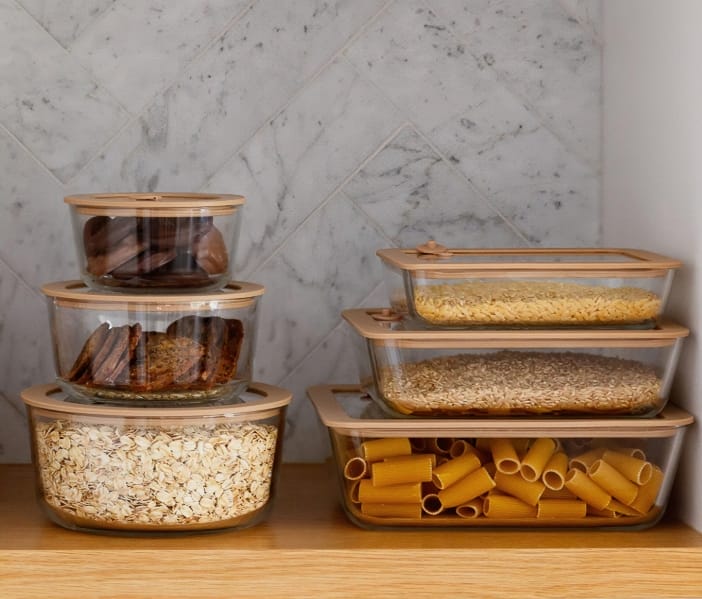
- Durable glass containers suitable for fridge, freezer, and oven use.
- Ideal for meal prep, leftovers, and batch cooking, with the ability to stack neatly for efficient storage.
- Attractive design.
- Outstanding customer service.
- Sometimes, the lids do not seal properly, so you might need to use bands to secure them tightly.
- Not 100% airtight or leak-proof, so they’re best for dry foods or non-liquidy leftovers.
Seed & Sprout stands out as a shop entirely free from plastic, featuring a range of products from eco-friendly food storage to camping gear.
Their Eco Stow containers, crafted from borosilicate glass with silicone rims, are my favorite. Not only is borosilicate safe and recyclable, it lasts longer than regular glass. That means your S&S containers are even more sustainable.
The adjustable air vent on each lid further sets these containers apart. Open it for perfect reheating conditions; close it for prolonged food freshness. I wouldn’t trust the lids with watery soups, but they handle thicker sauces just fine.
Choosing your style is simple, thanks to various container sizes and silicone rim colors like Oatmilk and Praline. Plus, S&S walks the walk when it comes to environmental responsibility.
From their zero-emissions HQ to their Silicone Take-Back program, buying from them means supporting a good cause.
#7: Life Without Plastic (Plastic-Free Shop)
- Materials: Borosilicate glass body. Bamboo lid. FDA-certified silicone seal. Stainless steel versions: 18/8 stainless steel. FDA silicone lid seal. 100% Plastic-free
- Appliances: Freezer, microwave, *dishwasher, and *oven-safe (*container only – not bamboo lid). Stainless: Freezer, dishwasher, and oven-safe (without silicone seal).
- Canada-based, made in India and China. Ships globally.
- Price range (food storage): $10 up to $123
- 1-year warranty
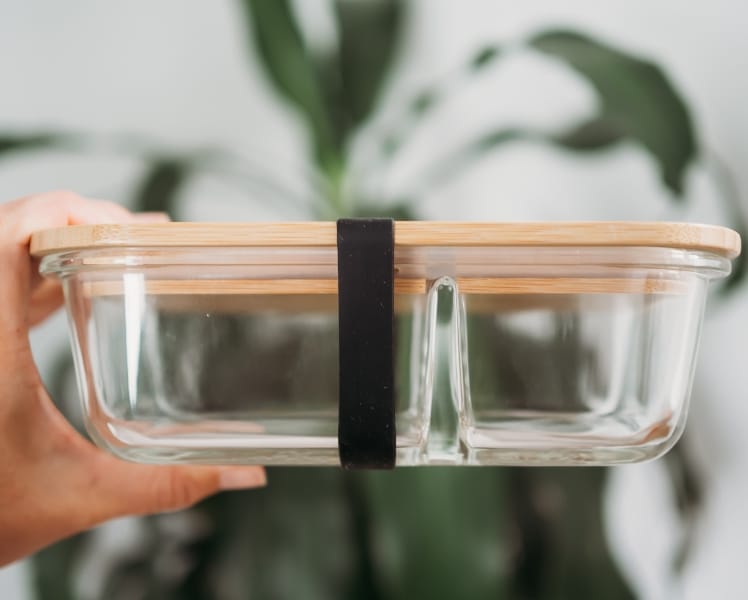
Life Without Plastic stands out as another plastic-free haven. Their divided, non-toxic glass container is a meal-prepping gem. It’s made from tough borosilicate glass for versatile heating and sustainability (outlasts typical glass).
I prefer bamboo lids over wood for their water resistance, making them less likely to warp. Bamboo is faster-growing than wood also, making these lids more eco-friendly.
For on-the-go, the silicone seal and included security bands ensure leak-free transport. However, the container is still glass and breakable if dropped. LWP offers a leak-proof 54oz all-stainless container for a more rugged travel pick. The steel divider version shines for more organized meal prep.
Lastly, LWP’s Green America-certified ethos extends to plastic-free packaging and ethical sourcing. Their strong commitment to sustainability makes them a top-notch choice all around.
#8: Kilner Jars
- Materials: Borosilicate glass. Silicone lid seal. 100% Plastic-free.
- Appliances: Freezer, oven, dishwasher, and microwave-safe
- UK-based, made in China. Ships to US and UK
- Price range (food jars): $30 to $65
- 14-day refund window
- Clasp mechanism with leak-proof silicone seal keeps food fresh and plastic-free.
- Suitable for a wide range of uses, including meal prep, storing leftovers, and canning.
- Classic look with thick, high-quality glass for easy visibility and durability.
- Problems with the clasp mechanism failing after a few months, hinting that quality isn’t what it used to be.
- Some jars arrive damaged, possibly due to inadequate packaging.
- Customer service can be lacking.
Kilner jars are my go-to for keeping mixed nuts fresh. Since 1842, Kilner has led the way in food preservation and sustainability for three reasons—its use of rugged glass, its patented vacuum seal system, and its iconic design.
These jars are made of borosilicate glass, excelling in durability and eco-friendliness. This infinitely recyclable material lasts longer than standard glass, reducing its environmental footprint.
And Kilner’s renowned pressure system plays a key role in keeping food fresh, helping reduce waste.
Kilner doesn’t stop at canning jars, either. Their product line includes everything from clip-top oil bottles to small spice jars. Their 68 oz clip-top jars shine for storing bulky items like vegetables, cereal, and pasta.
#9: Bee’s Wraps
- Beeswax Wraps: Organic cotton, beeswax, organic plant oil, and tree resin.
- Vegan Wraps: Organic cotton, candelilla wax (instead of beeswax), soy wax, organic coconut oil, and tree resin.
- 100% Plastic-free.
- Appliances: Fridge and *freezer-safe (*completely wrap the food to prevent freezer burn)
- Made in the USA. Ships globally.
- Price range: $5.99 up to $99
- 30-day warranty
- Reusable, eco-friendly alternative to plastic.
- Versatile design easily molds around various foods and works great to cover bowls.
- Simple to clean with cold water and mild soap, drying quickly for reuse.
- A pleasant aesthetic and mild, honey-like scent add to the user experience.
- The beeswax coating can deteriorate and leave wax on your food if you’re not careful when washing. So, use cold water and be gentle!
- Questionable lifespan; might not get 12 months of use, despite gentle care.
- The tree resins used might trigger allergies. If you have allergies, avoid them.
Bee’s Wraps are a must-have for non-toxic food storage. These responsibly sourced, US-made wax wraps offer a 100% plastic-free alternative to Saran wrap.
With just the warmth of your hands, they form a breathable seal around your food, preserving it longer than plastic. And they’re reusable for up to 12 months, claiming to save 1,667 sq. feet of plastic yearly per pack. After a year, Bee’s Wraps compost naturally into the earth. Or, if you’re a camper like me, they double as excellent fire starters!
I recommend the assorted 3-pack to start (large, medium, and small – one each), then stock up on your favorite size. Or, explore their bread wraps, DIY roll wraps, and wax food storage bags – great for heads of lettuce.
Beyond just food storage, Bee’s Wraps is committed to sustainability. They’re a certified B-Corp and 1% for the Planet member. Through these memberships, they actively work towards reducing pollution.
Hand-wash in cool water; air dry. Avoid hot water, storing near sunny windows, and leaving in hot cars, as these will ruin the wax.
Four Safest Food Storage Container Materials: Explained
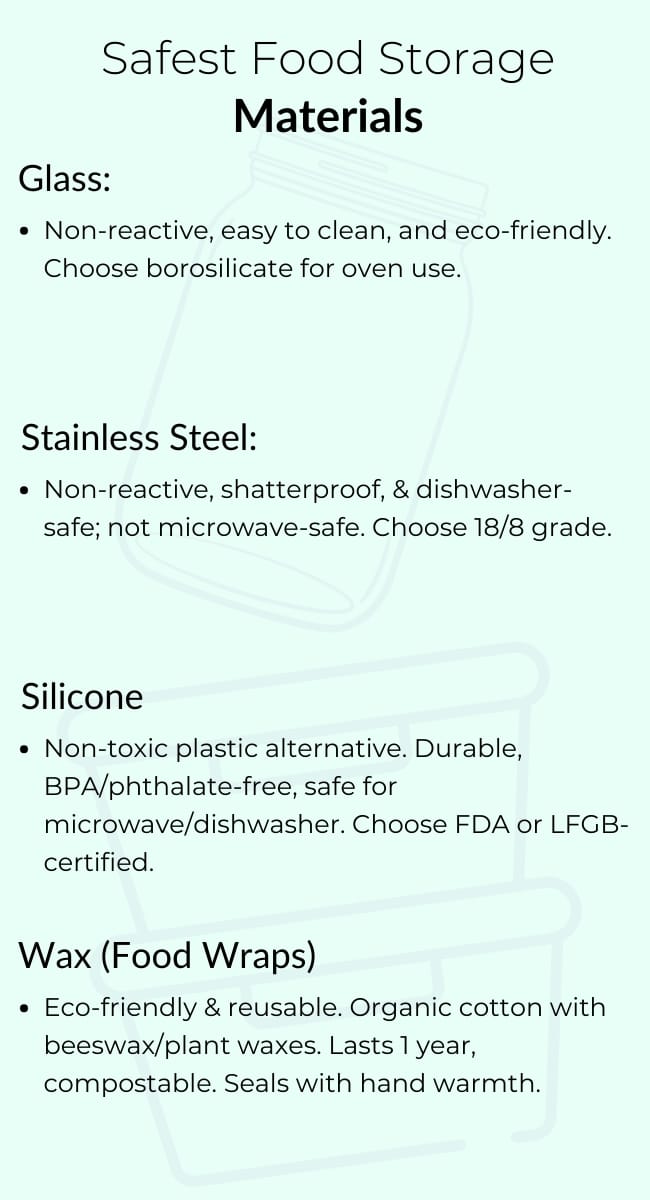
1. Glass: The Clean Champion
- Superpower: Doesn’t stain or react with food (even the acidic stuff!), so it’s great for everything.
- Microwave & Dishwasher Safe
- Eco-Friendly: Endlessly recyclable, making it kind to the planet.
- Bonus: For baking in the oven, choose “borosilicate” glass for extra toughness.
2. Stainless Steel: The Tough Titan
- Superpower: Resists rust and doesn’t leach chemicals, even with acidic or fatty foods. However, if you have a known allergy to chromium or nickel, you should avoid stainless steel cookware.
- Easy to Clean & Dishwasher-Safe
- Versatile: Perfect for fridge storage or oven reheating without risking thermal shock breakage.
- Bonus: Choose 18/8 (304-grade) for the best protection against corrosion.
3. Silicone: The Flexible Friend
- Superpower: Durable, eco-friendly, and heat-resistant, making it microwave and dishwasher-safe.
- Lightweight & Shatterproof.
- Bonus: Choose FDA-approved or LFGB-certified silicone for guaranteed safety. If an oily residue doesn’t come off after washing, a 15-minute boil will fix that.
4. Wax Food Wraps: The Eco-Hero
- Superpower: Made from organic cotton and beeswax (or plant-based waxes for vegans!), offering a sustainable and plastic-free alternative to Saran wrap.
- Reusable & Compostable: Use them for up to a year, then toss them in the compost bin.
- Bonus: Use your hand heat to loosen the wax and seal it around food, bowls, or containers.
Why You Should Avoid Plastic Food Containers: Health & Environmental Risks
Key Takeaways:
- Plastic Container Risk. Plastics can release harmful chemicals like BPA and phthalates into food, especially when heated. These chemicals pose health risks like endocrine disruption and developmental issues. Plastic also harms the environment through chemical and microplastic leaching. Even BPA-free plastics may not be safe.
- Choose Safer Alternatives: Opt for phthalate and Bisphenol-free options like glass, stainless steel, silicone, and wax. These materials are healthier, eco-friendly, and free from the drawbacks of plastic, such as lingering odors and stains.
The Details: Plastic containers can be problematic, especially when they’re old or heated. They might release harmful substances like BPA and phthalates into your food. This is particularly true for storing acidic foods in plastic containers and then reheating them.
You’ll find BPA in polycarbonates, a clear, hard plastic often used for reusable water bottles.
Phthalates, which make plastics soft and flexible, are usually in PVC. Unless labeled otherwise, it’s safe to assume that flexible plastics contain phthalates.
The issue with these chemicals is significant. They disrupt our endocrine system and can lead to:
- Developmental issues (especially in children) such as ADHD
- Heart problems
- Obesity
Even plastics labeled “BPA-free” may contain BPS or BPF instead of BPA, which pose similar health risks.
The environmental impact is equally concerning. Plastic containers can linger for centuries, polluting the planet and harming marine life. They release microplastics and other pollutants into the soil and water – UNEP.
So, it’s wise to choose alternatives free from phthalates and Bisphenols. Glass, stainless steel, silicone, and wax are healthier and better for the environment. They’re recyclable and don’t hold onto stains or odors like plastic can.
Safer Plastics for Food Storage Containers (& Which to Definitely Avoid)
I hesitate to say non-toxic plastic food storage containers exist. But, some plastics are safer than others for food storage:
Let’s quickly go over the safest (and most unsafe) plastics. Each has its resin code (recycling #) listed for easy identification at home.
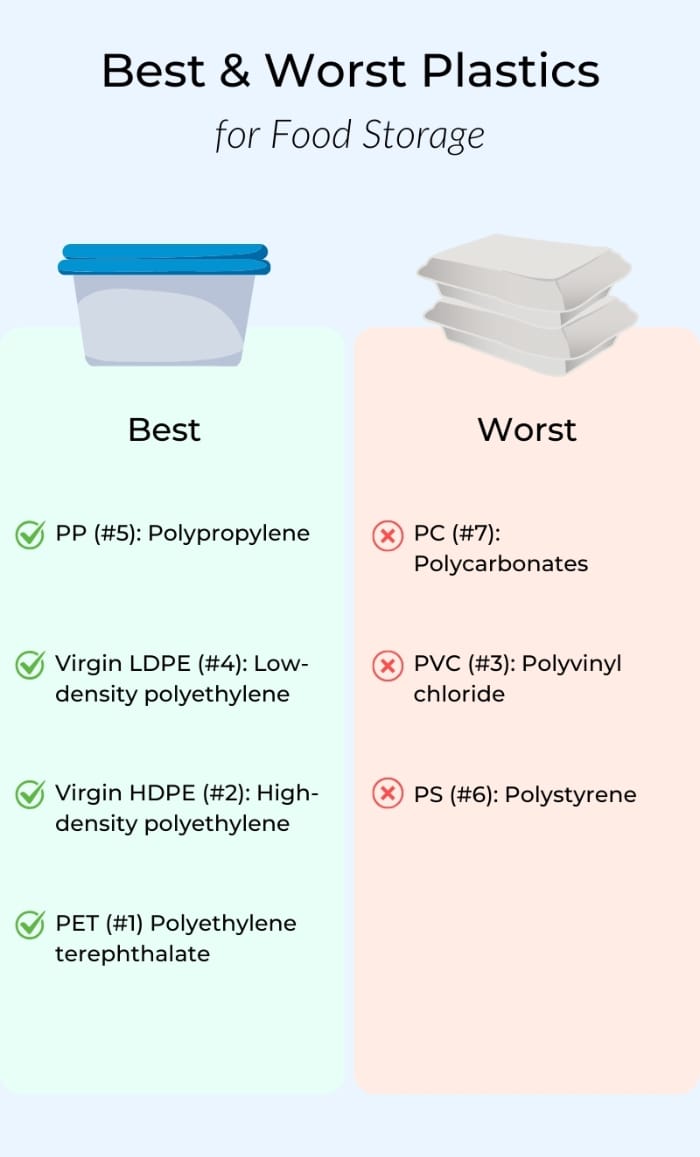
- PP: #5, Polypropylene. A stiff, heat-resistant plastic with a cloudy appearance. It’s often used in food storage containers and baby bottles. PP is ideal for food use due to its stability when heated.
- Virgin (non-recycled) LDPE: #4, Low-density polyethylene. This flexible plastic is chemically resistant and often used for PVC-free wraps and packaging. Avoid recycled LDPE for food storage as it becomes less safe when processed.
- Virgin (non-recycled) HDPE: #2, High-density polyethylene. Common in milk or juice bottles, yogurt cups, and laundry detergent bottles. This milky-white plastic resists moisture and doesn’t leach chemicals when heated. Recycled or reused HDPE is less safe.
- PET: #1, Polyethylene terephthalate. A semi-rigid, clear plastic often used in peanut butter or salad dressing containers. PET contains no harmful chemicals and fights corrosion, making it safer for food use.
- Pro tip: Generally, soft, flexible, and cloudy plastic containers are less likely to contain BPA.
Least safe plastics:
- PC: #7, Polycarbonates. A clear, hard plastic often used for food storage containers and kitchen appliances. It contains BPA and can leach these chemicals when heating food (especially acidic and alkaline foods) – NIH.
- PVC: #3, Polyvinyl chloride. Soft and flexible plastic often found in shower curtains. It contains phthalates that can leach into food when heated or exposed to fatty or acidic foods.
- PS: #6, polystyrene. Hard, brittle plastic that can leach the neurotoxin styrene when heated, though it’s safe in a solid, unheated state. You’ll often find PS in takeout containers and non-see-through disposable cutlery.
Reducing Risk with Any Plastic
Even if plastic is labeled “microwave-safe,” “BPA-free,” and “phthalate-free,” it can break down over time. It can leach trace amounts of production additives into food when that happens.
These leachable chemicals include degradation phenols and flame retardants such as triphenyl phosphate (TPP). Like bisphenols, they cause estrogenic activity in the body – EHJournal.
Plastic that is old/ worn-out, heated, or exposed to UV light increases the risk of leaching. Acidic foods are another stressor.
So, follow these guidelines to ensure safer usage with any plastic container:
- Avoid heating food in plastic containers.
- Do not serve hot food in plastic.
- Do not reuse single-use plastic containers (like commercial food packaging and takeout containers).
- Avoid washing plastic containers in the dishwasher.
- Dispose of old and worn-out plastic containers.
Recap & Conclusion
To wrap up, let’s quickly recap the main takeaways here:
- The best non-toxic food storage containers come in glass, stainless steel, silicone, and wax. We can also throw ceramic in the mix; just ensure it’s lead- and cadmium-free.
- Always choose 18/8 stainless steel for its durability and safety.
- For silicone, pick items certified by the FDA or LFGB, with the latter being the safest type.
- If using plastic, avoid PC (#7), PVC (#3), and PS (#6).
- Avoid microwaving plastic containers. Also, don’t reuse takeout containers; throw away any old or damaged Tupperware.
P.S. Now that you’ve got the gist of the safest food storage containers, it’s time to check your cookware for PFAS and heavy metals. See our safe cookware guide!

Hi there! I'm Adam, author and founder of TGL. Since 2016, I've produced and sold non-toxic kitchenware throughout the US. Today, I'm using my passion and experience in sustainable product manufacturing to help families avoid unsafe reusable foodware. When I'm not writing, you'll find me hiking or camping throughout Appalachia!
Related Posts

